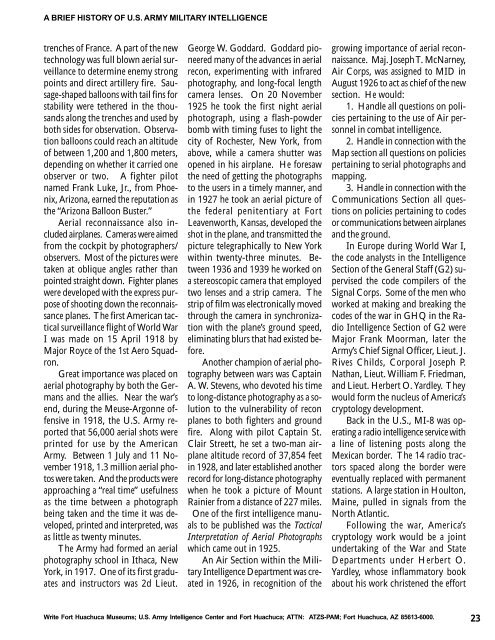Brief History of Army MI - Fort Huachuca - U.S. Army
Brief History of Army MI - Fort Huachuca - U.S. Army
Brief History of Army MI - Fort Huachuca - U.S. Army
You also want an ePaper? Increase the reach of your titles
YUMPU automatically turns print PDFs into web optimized ePapers that Google loves.
A BRIEF HISTORY OF U.S. ARMY <strong>MI</strong>LITARY INTELLIGENCEtrenches <strong>of</strong> France. A part <strong>of</strong> the newtechnology was full blown aerial surveillanceto determine enemy strongpoints and direct artillery fire. Sausage-shapedballoons with tail fins forstability were tethered in the thousandsalong the trenches and used byboth sides for observation. Observationballoons could reach an altitude<strong>of</strong> between 1,200 and 1,800 meters,depending on whether it carried oneobserver or two. A fighter pilotnamed Frank Luke, Jr., from Phoenix,Arizona, earned the reputation asthe “Arizona Balloon Buster.”Aerial reconnaissance also includedairplanes. Cameras were aimedfrom the cockpit by photographers/observers. Most <strong>of</strong> the pictures weretaken at oblique angles rather thanpointed straight down. Fighter planeswere developed with the express purpose<strong>of</strong> shooting down the reconnaissanceplanes. The first American tacticalsurveillance flight <strong>of</strong> World WarI was made on 15 April 1918 byMajor Royce <strong>of</strong> the 1st Aero Squadron.Great importance was placed onaerial photography by both the Germansand the allies. Near the war’send, during the Meuse-Argonne <strong>of</strong>fensivein 1918, the U.S. <strong>Army</strong> reportedthat 56,000 aerial shots wereprinted for use by the American<strong>Army</strong>. Between 1 July and 11 November1918, 1.3 million aerial photoswere taken. And the products wereapproaching a “real time” usefulnessas the time between a photographbeing taken and the time it was developed,printed and interpreted, wasas little as twenty minutes.The <strong>Army</strong> had formed an aerialphotography school in Ithaca, NewYork, in 1917. One <strong>of</strong> its first graduatesand instructors was 2d Lieut.George W. Goddard. Goddard pioneeredmany <strong>of</strong> the advances in aerialrecon, experimenting with infraredphotography, and long-focal lengthcamera lenses. On 20 November1925 he took the first night aerialphotograph, using a flash-powderbomb with timing fuses to light thecity <strong>of</strong> Rochester, New York, fromabove, while a camera shutter wasopened in his airplane. He foresawthe need <strong>of</strong> getting the photographsto the users in a timely manner, andin 1927 he took an aerial picture <strong>of</strong>the federal penitentiary at <strong>Fort</strong>Leavenworth, Kansas, developed theshot in the plane, and transmitted thepicture telegraphically to New Yorkwithin twenty-three minutes. Between1936 and 1939 he worked ona stereoscopic camera that employedtwo lenses and a strip camera. Thestrip <strong>of</strong> film was electronically movedthrough the camera in synchronizationwith the plane’s ground speed,eliminating blurs that had existed before.Another champion <strong>of</strong> aerial photographybetween wars was CaptainA. W. Stevens, who devoted his timeto long-distance photography as a solutionto the vulnerability <strong>of</strong> reconplanes to both fighters and groundfire. Along with pilot Captain St.Clair Streett, he set a two-man airplanealtitude record <strong>of</strong> 37,854 feetin 1928, and later established anotherrecord for long-distance photographywhen he took a picture <strong>of</strong> MountRainier from a distance <strong>of</strong> 227 miles.One <strong>of</strong> the first intelligence manualsto be published was the TacticalInterpretation <strong>of</strong> Aerial Photographswhich came out in 1925.An Air Section within the MilitaryIntelligence Department was createdin 1926, in recognition <strong>of</strong> thegrowing importance <strong>of</strong> aerial reconnaissance.Maj. Joseph T. McNarney,Air Corps, was assigned to <strong>MI</strong>D inAugust 1926 to act as chief <strong>of</strong> the newsection. He would:1. Handle all questions on policiespertaining to the use <strong>of</strong> Air personnelin combat intelligence.2. Handle in connection with theMap section all questions on policiespertaining to serial photographs andmapping.3. Handle in connection with theCommunications Section all questionson policies pertaining to codesor communications between airplanesand the ground.In Europe during World War I,the code analysts in the IntelligenceSection <strong>of</strong> the General Staff (G2) supervisedthe code compilers <strong>of</strong> theSignal Corps. Some <strong>of</strong> the men whoworked at making and breaking thecodes <strong>of</strong> the war in GHQ in the RadioIntelligence Section <strong>of</strong> G2 wereMajor Frank Moorman, later the<strong>Army</strong>’s Chief Signal Officer, Lieut. J.Rives Childs, Corporal Joseph P.Nathan, Lieut. William F. Friedman,and Lieut. Herbert O. Yardley. Theywould form the nucleus <strong>of</strong> America’scryptology development.Back in the U.S., <strong>MI</strong>-8 was operatinga radio intelligence service witha line <strong>of</strong> listening posts along theMexican border. The 14 radio tractorsspaced along the border wereeventually replaced with permanentstations. A large station in Houlton,Maine, pulled in signals from theNorth Atlantic.Following the war, America’scryptology work would be a jointundertaking <strong>of</strong> the War and StateDepartments under Herbert O.Yardley, whose inflammatory bookabout his work christened the effortWrite <strong>Fort</strong> <strong>Huachuca</strong> Museums; U.S. <strong>Army</strong> Intelligence Center and <strong>Fort</strong> <strong>Huachuca</strong>; ATTN: ATZS-PAM; <strong>Fort</strong> <strong>Huachuca</strong>, AZ 85613-6000.23
















